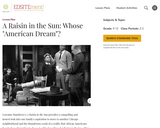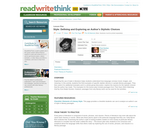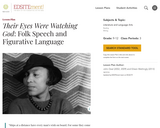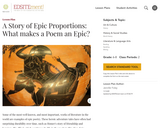
Activities and worksheets on the use and identification of metaphors.
- Subject:
- English Language Arts
- Material Type:
- Activity/Lab
- Provider:
- Spelling City
- Author:
- Spelling City
- Date Added:
- 02/26/2019

Activities and worksheets on the use and identification of metaphors.

In this DBQ Project lesson plan, students will examine ten documents to explore the Mongols and determine how barbaric the barbarians actually were.

In this mini document based question activity from the DBQ Project, students will examine four texts to discover the clues that foreshadow key events in author John Steinbeck's Of Mice and Men.

Activities and worksheets on the use and identification of personification.

Lorraine Hansberry's A Raisin in the Sun provides a compelling and honest look into one family's aspirations to move to another Chicago neighborhood and the thunderous crash of a reality that raises questions about for whom the "American Dream" is accessible.

This resource includes a lesson and accompanying activities designed to assist learners at the high school level with engaging with similes on a deeper level. Students will spend time reading excerpts from Robert Frost, William Wordsworth and Toi Derricotte in an attempt to better understand the function of similes. Students will analyze similes from the sources and students will practice writing their own similes using predefined topics.

Activities and worksheets on the use and identification of similies.

In this lesson, students analyze songs as an introduction to poetry. Students search songs for examples of poetic devices and assemble them in a storyboard that matches each term with an illustration and a line from the song.

This lesson focuses on the author's use of language; moreover, how it is used to convey mood, images, and meaning. Students are tasked here with examining a selection identifying examples of stylistic devices within the passages. Next, students discuss possible reasons for author's selected style choices. The lesson is detailed with examples from Zora Neale Hurston's Their Eyes Were Watching God, yet the lesson may be altered to be used with other instructor selected text.

Exploring the use of style in literature helps students understand how language conveys mood, images, and meaning. After exploring the styles of two authors, students will translate passages from one author into the style of another. Then they will translate fables into style of one of the authors.

In this lesson, students learn to differentiate between denotation and connotation by using associations with names.

Through close readings of Zora Neale Hurston'sTheir Eyes Were Watching God, students will analyzehow Hurston creates a unique literary voice by combining folklore, folk language, and traditional literary techniques. Students will examine the role that folk groups play in both their own lives and in the novel.

This lesson is part of a larger unit dealing with Early American Literature. In this lesson, students will become familiar with the figurative devices and strategies used by 17th century Puritan poets when creating closed or fixed form poetry.

This lesson introduces students to the epic poem form and its roots in oral tradition. Students will learn about the epic hero cycle and will learn how to recognize this pattern of events and elements. They will also be introduced to the patterns embedded in these stories that have helped generations of storytellers remember these immense poems.

Three-minute video with definitions for verbal irony and sacarsm. Contains links for a worksheet and follow-up video exemplars.